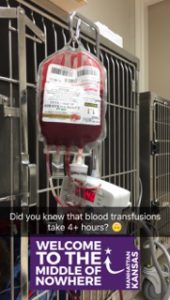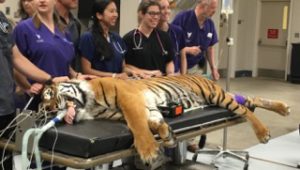I have just finished my second week here at the KSU VHC, and it has been just as exciting as the first. This week was filled with endoscopy, blood transfusions, a Clinical Pathology book that weighs more than I do, more getting lost in hallways (I’m getting better), and of course, the highlight of my week: a tiger. Yeah, a tiger.
Malik is a 9-year-old male intact Siberian tiger that lives in the Manhattan Zoo. He has a history of vomiting and gastrointestinal problems. He came in to have a liver biopsy due to presenting signs of possible liver disease. Everything was going smoothly until he had a reaction to the anesthetic he was under and his heart stopped beating. He was down for eight minutes and the surgeons managed to resuscitate him. His heart had been beating for five  minutes when he coded a second time, this time for fifteen minutes. They had to switch out people to do compressions four times but they managed to save Malik’s life. They then preformed the procedure and sent him home to the Sunset Zoo, where Malik is alive, happy, and being treated and monitored for his condition. That incredible, chaotic event was by far one of the most amazing and intense things I have ever witnessed.
minutes when he coded a second time, this time for fifteen minutes. They had to switch out people to do compressions four times but they managed to save Malik’s life. They then preformed the procedure and sent him home to the Sunset Zoo, where Malik is alive, happy, and being treated and monitored for his condition. That incredible, chaotic event was by far one of the most amazing and intense things I have ever witnessed.
In less eventful but still important news, I am able to understand things much easier now and I am now able to keep up, for the most part, with cases and terms. I also got a new, smaller lab coat from one of the vet students that fits me much better than the one from last week. I’m much younger than all of the students, and I walk around eating fruit snacks and drinking juice (I promise I’m not kidding), so I really don’t need a gigantic lab coat to help me look like a child.
I have also, through listening to the vet students present cases to clinicians, learned how to present an animal. Here is an example of how I would present a case to a clinician:
“This is Hadley. She is a 17 year old, female intact, standard human. She presented about two weeks ago with slight back and shoulder pain and tenderness in the feet. We associate this to long amounts of time on her feet. She has been sleeping excessively and eats almost anything. She was also exceptionally talkative on presentation and has continued this trend. She seems to be learning a lot and is constantly taking in every piece of information she can find around her. We have been monitoring her status hourly and for the most part she seems normal. She is bright, happy, and alert and we are increasing the amount of sleep we allow her to have. We are giving her plenty of fluids to keep her hydrated and giving her food at least three times a day. We have been giving her 400mgs of non-steroidal anti-inflammatory (ibuprofen) once every four hours. She is responding well to the treatment so far and we should be able to send her home in about four weeks.”


There are no comments published yet.